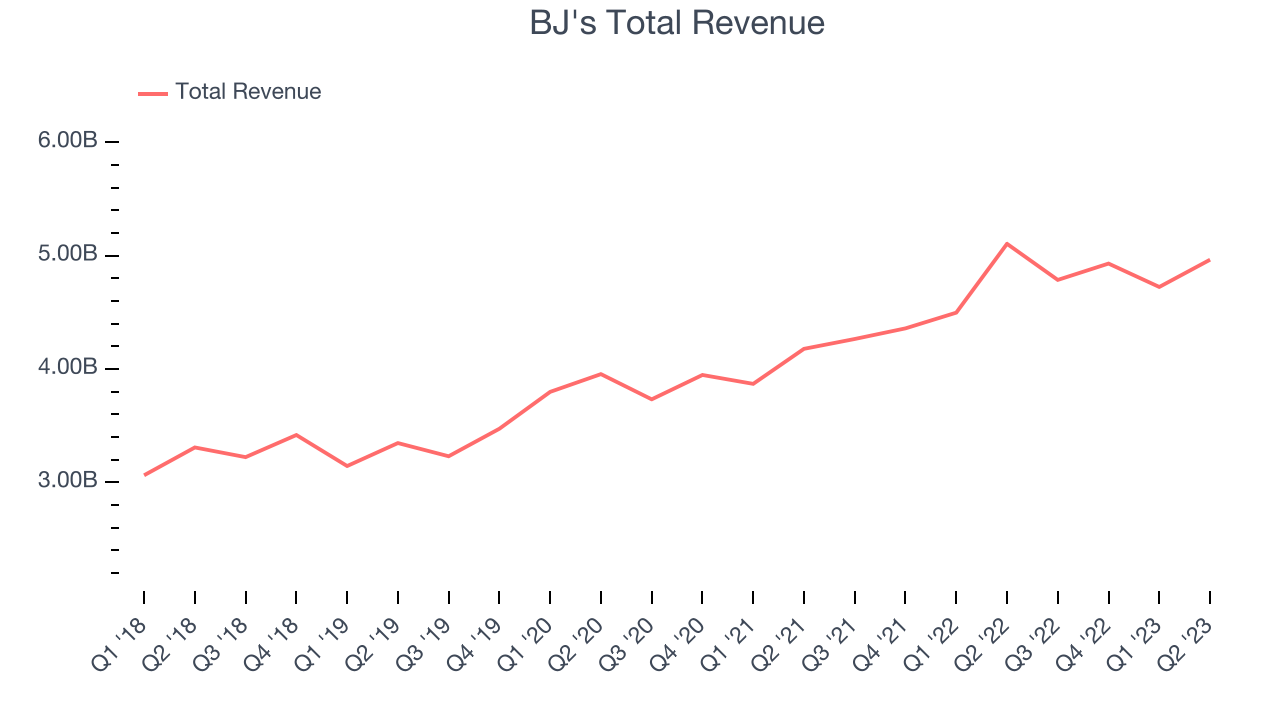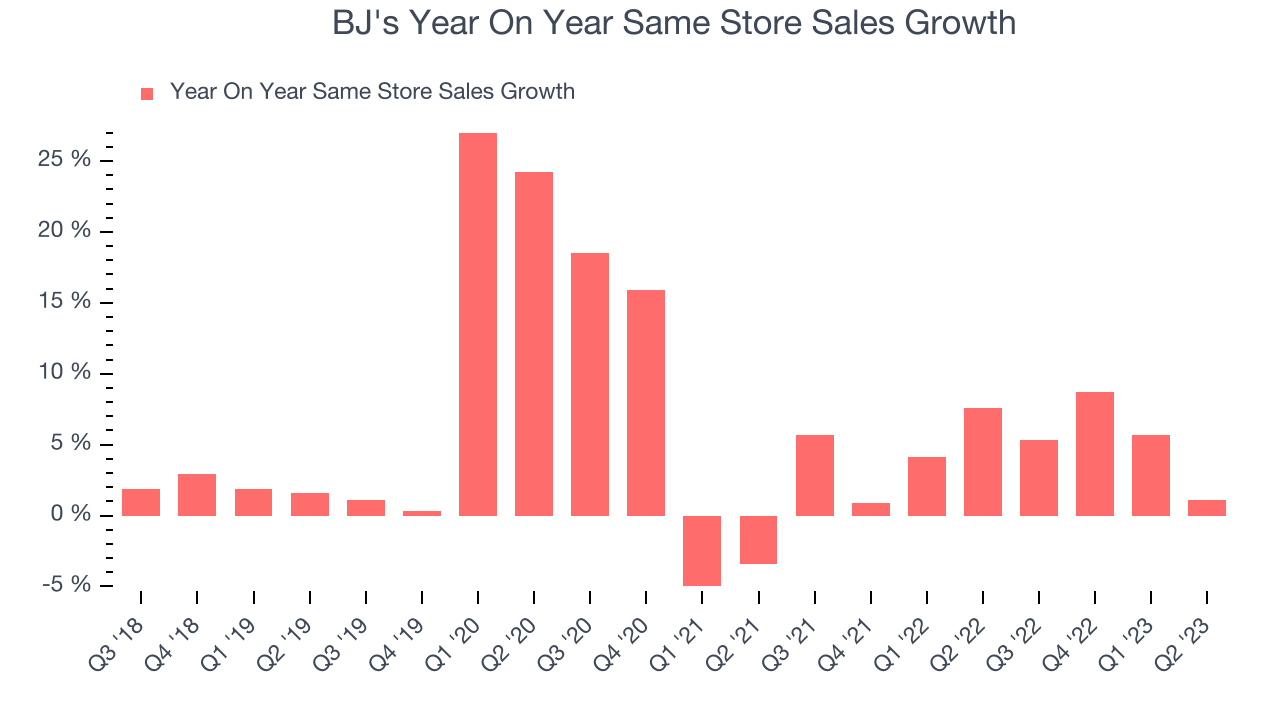Membership-only discount retailer BJ’s Wholesale Club (NYSE:BJ) fell short of analysts' expectations in Q2 FY2023, with revenue down 2.75% year on year to $4.96 billion. BJ's made a GAAP profit of $131.3 million, down from its profit of $141 million in the same quarter last year.
Is now the time to buy BJ's? Find out by accessing our full research report, it's free.
BJ's (BJ) Q2 FY2023 Highlights:
- Revenue: $4.96 billion vs analyst estimates of $5.17 billion (4.06% miss)
- EPS (non-GAAP): $0.97 vs analyst estimates of $0.91 (6.81% beat)
- Free Cash Flow of $34.2 million, up -88.5% from the same quarter last year
- Gross Margin (GAAP): 18.1%, up from 16.9% in the same quarter last year
- Same-Store Sales were up 1.1% year on year
- Store Locations: 406 at quarter end, increasing by 17 over the last 12 months
“Our strong performance in the second quarter reflects our continued gains in membership, traffic and market share, driven by the great value that we provide our members every day,” said Bob Eddy, Chairman and Chief Executive Officer, BJ’s Wholesale Club.
Appealing to the budget-conscious individual shopping for a household, BJ’s Wholesale Club (NYSE:BJ) is a membership-only retail chain that sells groceries, appliances, electronics, and household items, often in bulk quantities.
Big-box retailers operate large stores that sell groceries and general merchandise at highly competitive prices. Because of their scale and resulting purchasing power, these big-box retailers–with annual sales in the tens to hundreds of billions of dollars–are able to get attractive volume discounts and sell at often the lowest prices. While e-commerce is a threat, these retailers have been able to weather the storm by either providing a unique in-store shopping experience or by reinvesting their hefty profits into omnichannel investments.
Sales Growth
BJ's is one of the larger companies in the consumer retail industry and benefits from economies of scale, enabling it to gain more leverage on fixed costs and offer consumers lower prices.
As you can see below, the company's annualized revenue growth rate of 10.3% over the last four years (we compare to 2019 to normalize for COVID-19 impacts) was impressive as it opened new stores and grew sales at existing, established stores.

This quarter, BJ's reported a rather uninspiring 2.75% year-on-year revenue decline, missing analysts' expectations. Looking ahead, the analysts covering the company expect sales to grow 8.54% over the next 12 months.
The pandemic fundamentally changed several consumer habits. There is a founder-led company that is massively benefiting from this shift. The business has grown astonishingly fast, with 40%+ free cash flow margins. Its fundamentals are undoubtedly best-in-class. Still, the total addressable market is so big that the company has room to grow many times in size. You can find it on our platform for free.
Number of Stores
A retailer's store count is a crucial factor influencing how much it can sell, and store growth is a critical driver of how quickly its sales can grow.
When a retailer like BJ's is opening new stores, it usually means that demand is greater than supply, and in turn, it's investing for growth. Since last year, BJ's store count increased by 17 locations, or 4.37%, to 406 total retail locations in the most recently reported quarter.
Over the last two years, the company has generally opened new stores and averaged 4.06% annual growth in its physical footprint, which is decent and on par with the broader sector. With an expanding store base and demand, revenue growth can come from multiple vectors: sales from new stores, sales from e-commerce, or increased foot traffic and higher sales per customer at existing stores.
Same-Store Sales
Same-store sales growth is an important metric that tracks demand for a retailer's established brick-and-mortar stores and e-commerce platform.
BJ's demand within its existing stores has generally risen over the last two years but lagged behind the broader consumer retail sector. On average, the company's same-store sales have grown by 4.89% year on year. With positive same-store sales growth amid an increasing physical footprint of stores, BJ's is reaching more customers and growing sales.

In the latest quarter, BJ's same-store sales rose 1.1% year on year. By the company's standards, this growth was a meaningful deceleration from the 7.6% year-on-year increase it had posted 12 months ago. One quarter fluctuations aren't material for the long-term prospects of a business, but we'll watch BJ's closely to see if it can reaccelerate growth.
Key Takeaways from BJ's Q2 Results
Sporting a market capitalization of $9.37 billion, BJ's is among smaller companies, but its more than $26.2 million in cash on hand and positive free cash flow over the last 12 months puts it in an attractive position to invest in growth.
It was good to see BJ's beat analysts' EPS and EBITDA expectations this quarter. That really stood out as a positive in these results. On the other hand, its revenue unfortunately missed Wall Street's expectations. Overall, the results could have been better. The company is down 2.91% on the results and currently trades at $67.7 per share.
So should you invest in BJ's right now? When making that decision, it's important to consider its valuation, business qualities, as well as what has happened in the latest quarter. We cover that in our actionable full research report which you can read here, it's free.
One way to find opportunities in the market is to watch for generational shifts in the economy. Almost every company is slowly finding itself becoming a technology company and facing cybersecurity risks and as a result, the demand for cloud-native cybersecurity is skyrocketing. This company is leading a massive technological shift in the industry and with revenue growth of 50% year on year and best-in-class SaaS metrics it should definitely be on your radar.
The author has no position in any of the stocks mentioned in this report.
